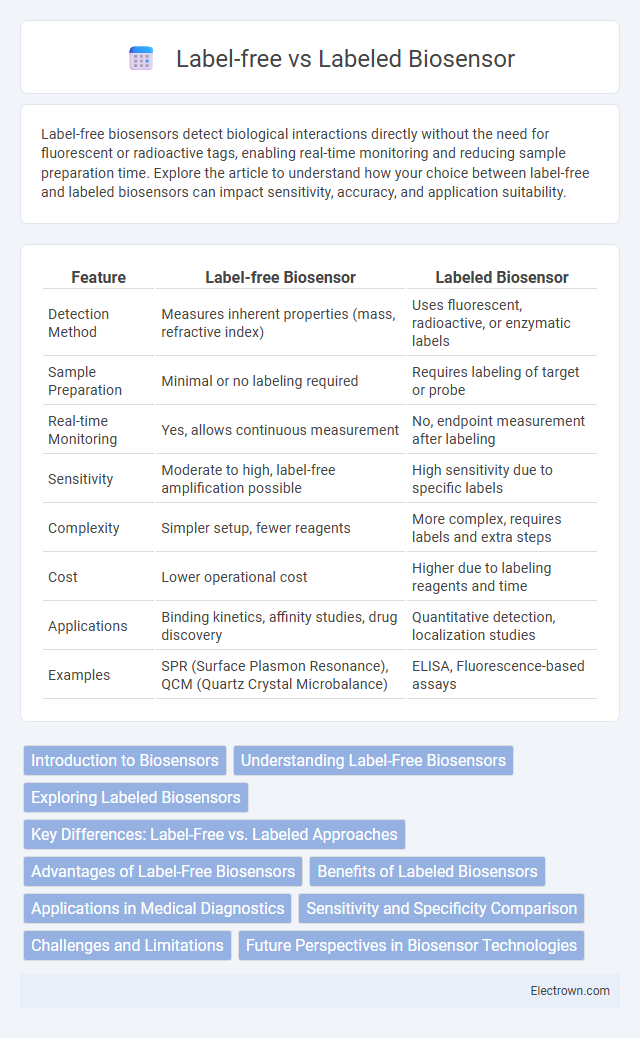Label-free biosensors detect biological interactions directly without the need for fluorescent or radioactive tags, enabling real-time monitoring and reducing sample preparation time. Explore the article to understand how your choice between label-free and labeled biosensors can impact sensitivity, accuracy, and application suitability.
Table of Comparison
| Feature | Label-free Biosensor | Labeled Biosensor |
|---|---|---|
| Detection Method | Measures inherent properties (mass, refractive index) | Uses fluorescent, radioactive, or enzymatic labels |
| Sample Preparation | Minimal or no labeling required | Requires labeling of target or probe |
| Real-time Monitoring | Yes, allows continuous measurement | No, endpoint measurement after labeling |
| Sensitivity | Moderate to high, label-free amplification possible | High sensitivity due to specific labels |
| Complexity | Simpler setup, fewer reagents | More complex, requires labels and extra steps |
| Cost | Lower operational cost | Higher due to labeling reagents and time |
| Applications | Binding kinetics, affinity studies, drug discovery | Quantitative detection, localization studies |
| Examples | SPR (Surface Plasmon Resonance), QCM (Quartz Crystal Microbalance) | ELISA, Fluorescence-based assays |
Introduction to Biosensors
Biosensors are analytical devices that convert a biological response into an electrical signal for detecting specific analytes. Label-free biosensors detect targets directly through intrinsic properties such as mass, refractive index, or electrical impedance without the need for attached markers, enabling real-time and non-invasive measurements. Labeled biosensors rely on tags like fluorescent dyes or enzymes to generate a detectable signal, often providing higher sensitivity but requiring additional preparation steps.
Understanding Label-Free Biosensors
Label-free biosensors detect biomolecular interactions without the need for fluorescent or radioactive tags, enabling real-time monitoring of binding events and kinetic analysis. These sensors commonly utilize techniques such as surface plasmon resonance (SPR), quartz crystal microbalance (QCM), and optical waveguide-based detection to measure changes in mass, refractive index, or electrical properties directly at the sensor surface. Label-free biosensors offer high sensitivity, reduced sample preparation time, and the capability to analyze complex biological samples without interference from labeling molecules.
Exploring Labeled Biosensors
Labeled biosensors utilize specific tags or markers, such as fluorescent dyes or enzymes, to detect target molecules with high sensitivity and specificity. These biosensors enable precise quantification and visualization of biochemical interactions, making them ideal for applications in medical diagnostics and environmental monitoring. You can leverage labeled biosensors for enhanced detection accuracy in complex sample analysis where direct signal measurement is challenging.
Key Differences: Label-Free vs. Labeled Approaches
Label-free biosensors detect analytes directly through intrinsic properties such as refractive index or mass changes, enabling real-time, dynamic monitoring without the need for additional molecular tags. Labeled biosensors rely on fluorescent, radioactive, or enzymatic markers attached to target molecules, offering high sensitivity and specificity but requiring complex sample preparation. The key differences lie in the trade-offs between the simplicity and speed of label-free methods versus the enhanced detection limits and multiplexing capabilities of labeled approaches.
Advantages of Label-Free Biosensors
Label-free biosensors offer real-time monitoring of biomolecular interactions without the need for fluorescent or radioactive labels, preserving the native state of analytes for more accurate results. These sensors reduce sample preparation time and costs, while enabling continuous analysis and high-throughput screening in clinical diagnostics and environmental monitoring. Your experiments benefit from increased sensitivity and faster data acquisition, making label-free biosensors ideal for dynamic studies and point-of-care applications.
Benefits of Labeled Biosensors
Labeled biosensors offer enhanced sensitivity and specificity by using tags such as fluorophores or enzymes to generate measurable signals, facilitating precise detection of target analytes even at low concentrations. These biosensors provide rapid and quantifiable results, enabling high-throughput screening and real-time monitoring in complex biological samples. Their ability to amplify signals significantly improves detection limits, making them ideal for diagnostic applications and drug discovery processes.
Applications in Medical Diagnostics
Label-free biosensors provide rapid, real-time detection of biomolecules such as proteins and nucleic acids, enabling early disease diagnosis and continuous monitoring of health conditions without the need for fluorescent or radioactive labels. Labeled biosensors enhance sensitivity and specificity through the use of tagged antibodies or probes, making them ideal for detecting low-abundance biomarkers in cancer and infectious disease diagnostics. Both technologies are integral to point-of-care testing, personalized medicine, and the development of next-generation diagnostic platforms.
Sensitivity and Specificity Comparison
Label-free biosensors offer real-time detection with high sensitivity by directly measuring biomolecular interactions without the need for fluorescent or radioactive labels, reducing potential interference and preserving biomolecule functionality. Labeled biosensors often achieve higher specificity through targeted recognition elements conjugated with detectable tags, enhancing signal clarity but sometimes introducing complexity and affecting binding affinity. Your choice between these biosensor types depends on balancing the demand for sensitivity in detecting low-abundance analytes against the need for specificity in distinguishing closely related molecular targets.
Challenges and Limitations
Label-free biosensors face challenges such as reduced sensitivity in complex biological samples and difficulty distinguishing target molecules from background noise. Labeled biosensors often suffer from limitations like potential alteration of biomolecule function due to labeling and additional steps increasing assay time and cost. Both technologies encounter issues with reproducibility and scalability in real-world diagnostic applications.
Future Perspectives in Biosensor Technologies
Label-free biosensors offer real-time, cost-effective detection by eliminating the need for fluorescent or radioactive tags, enhancing applications in point-of-care diagnostics and environmental monitoring. Labeled biosensors, with their high sensitivity and specificity through established tagging methods, continue to advance in multiplexed assays and imaging technologies. Future perspectives in biosensor technologies emphasize integrating nanomaterials, artificial intelligence, and microfluidics to improve sensitivity, portability, and data analysis for both label-free and labeled detection platforms.
Label-free vs Labeled Biosensor Infographic

 electrown.com
electrown.com